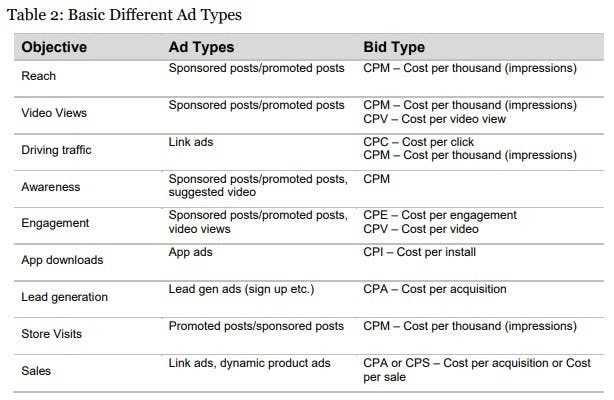Audiences
Let’s start with audiences. Defining these people needs to be done clearly from the outset of any paid social campaign. In addition, you need to consider how your social ads can invoke the desired reaction to the service or product you’re promoting.
To do this, it’s imperative to research your audience’s behaviour…
- What platforms are they using?
- Where are they likely to be?
- What type of media do they consume?
All of this data will not only help inform your creative but also where and when to target your desired audience – the major social platforms now give you the tools and means to do this through website retargeting and customer/matched/tailored targeting (using data collected from your customers via channels like email and mobile).
Campaign purpose
What are you trying to achieve through your campaign? Are you trying to raise brand awareness, or are you trying to drive a specific, direct response? This will impact your creative, as well as campaign structure, in addition to your reporting and measurement approach.
Ultimately, your campaign objectives (brand awareness, consideration, conversion etc.) will define which approach and ad format you chose to use.
For your campaign to be effective, it’s critical to ensure your ads stand out from the rest, with a clearly defined message that’s in the right format and context.
Ad Formats
These vary from platform to platform, are updated frequently and sometimes even consigned to the ad format graveyard (e.g. see Twitter retiring their lead gen ad format, last year).
Below is a table that shows the social ad types available, how they are used and what advertisers bid on:

Targeting
You want your messages to reach your desired audience.
Paid social advertising has become increasingly complex with the development of new tools that provide marketers with many ways to target their audiences. Below I’ve listed some of the targeting options available:
- Demographic: information such as age or gender.
- Location: where do your customers live?
- Interests: this can range from hobbies that they’ve listed to pages that they’ve liked to (in the case of some social networks) ads they’ve previously clicked.
- Behaviours: based on the network’s data or third-party data – advertisers can target customers on device usage, purchase behaviour and more.
- Custom audiences: you can use network tools to upload your external customer database to find particular customers and target them on the network of your choice (this will only work if the information you have on them matches the data the network also has, e.g. email address, phone number)
- Friend: customers can be targeted based on their friends’ social activity. The aim of this option is to use social proof as leverage – ‘[your friend] likes this page’. This tends to elicit more action than an entirely cold ad.
- Lookalike audiences: platform tools can allow you to find and target customers similar to your own by building a lookalike audience from page likes, customer lists or website visitors.
- Remarketing: some social platforms allow marketers to embed a pixel on their site to monitor visitor behaviour and retarget them – an example of this includes serving dynamic product ads, which are displayed to potential customers after they’ve viewed a particular product.
There is still some uncertainty around the use of interest based advertising, so it’s important to tread softly and only use interests that are not deemed ‘sensitive’ - political, religious, and relationship information etc. Last month, Facebook released a list of 20 national issues that require advertiser authorisation before ads can be published, even if you’re an advertiser that doesn’t reside in the US. With the GDPR in effect, now more than ever, you also need to ensure you have the necessary consents to be compliant with the regulation when targeting your audience.
Timing
Competitor activity, seasonality and any recent news or events are all things you should think about when putting your campaign together, and also whilst your campaign is active.
Perception is important for marketers to keep in mind because certain topics, themes and even words, can be seen as distasteful if the context or timing is wrong. A poorly timed ad or an ad which has potentially offensive content can have a lasting effect on the way your brand is perceived on social (and in general).
Ads appearing next to horrific news events on people’s social media feeds could cause offence and turn people off, as it shows a potential lack of consideration for people affected.
It’s important to have the flexibility to pause campaigns that could appear inconsiderate and insensitive. A mistimed ad can severely damage your brand.
Bidding Strategy
All ad buying on social media platforms work on an auction model, which means you need a bidding strategy in place. Let’s consider why having one is necessary and can effect on your ad getting selected and shown. (N.B. Here I’m going to focus on Facebook)
Getting your bids right is crucial and if you don’t get them right, one of these two problems could arise:
- You end up paying far more for your media placements than you should
- Your ads don’t get delivered because your bids are so low that they are restricted
Both of these points are cost related, and bidding is a bit of balancing act. Having a strategy in place helps ensure neither of the above happen and you don’t end up spending too much – thus decreasing the ROI of your ads – or spending too little – to the detriment of your campaigns efficacy.
Spend is just one factor that plays a part in the overall success of an ad. Alongside the monetary value bidded for a ‘required action’ (e.g. website click), Facebook also looks at something called an estimated action rate. This is described as a representation of how likely Facebook thinks one of its users will take the action outlined in your initial bid – is your ad likely to invoke the desired action and is it relevant to someone’s interests?
Facebook bases the estimate on the historical actions of your desired audience as well as your previous performance data. This ties into another factor to think about when bidding – ad quality and relevance score. This is basically Facebook’s measure of how they perceive your ad. If your ad receives negative feedback (e.g. people marking it as spam), this will affect your score and consequently, the likelihood of your ad appearing in front of your target audience. On the contrary, if someone takes the action that you’ve intended when you initially bid, this will boost your score and overall ad efficacy.
You can dive deeper into the practical application of bidding in our Paid Social Media Advertising Guide but you should keep in mind that your social ad campaign objectives and Facebook’s ad objectives should be as closely aligned as possible. Producing ads that are relevant and unintrusive to the audience’s overall experience on the platform should be a top priority for you (and Facebook alike) and this all ties into your overall bidding strategy.


Comments